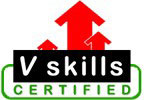Course Outline
Enterprise-Wide Deployment
- Enterprise-Wide View: Understand how Six Sigma applies across an entire organization.
- Leadership: Explore the role of leadership in driving Six Sigma initiatives.
- Organizational Process Management and Measures: Learn how to manage and measure processes effectively.
- Impact on Stakeholders: Identify how Six Sigma affects customers, employees, and investors.
- CTx Requirements: Understand critical-to-quality (CTQ), critical-to-cost (CTC), and other key metrics.
- Benchmarking: Compare performance against industry standards for continuous improvement.
- Business Performance Measures: Learn to assess business success through key performance indicators (KPIs).
- Financial Measures: Understand cost savings, ROI, and other financial impacts of Six Sigma.
Team Management
- Team Formation: Learn how to build a strong and effective Six Sigma team.
- Team Facilitation: Understand techniques for guiding team discussions and problem-solving.
- Team Dynamics: Explore interpersonal relationships and collaboration within teams.
- Time Management: Learn strategies for managing project timelines and resources.
- Decision-Making Tools: Use structured tools to make data-driven decisions.
- Management and Planning Tools: Apply tools like SWOT, fishbone diagrams, and process mapping.
- Team Performance Evaluation and Reward: Understand methods for assessing and incentivizing team success.
Define Phase
- Voice of the Customer (VoC): Capture customer needs and translate them into project goals.
- Project Charter: Learn to create a project charter outlining scope, goals, and deliverables.
- Project Tracking: Monitor progress using Six Sigma tracking tools.
Measure Phase
- Process Characteristics: Identify key process variables affecting performance.
- Data Collection: Learn techniques for gathering accurate and relevant data.
- Measurement Systems: Ensure reliable measurement methods for Six Sigma analysis.
- Statistics: Apply statistical tools to analyze process performance.
- Probability: Understand probability concepts for quality control and risk assessment.
- Process Capability: Evaluate how well a process meets customer specifications.
Analyze Phase
- Modeling and Measuring Between Variables: Understand relationships between process factors.
- Hypothesis Testing: Use statistical methods to validate improvements.
- FMEA (Failure Mode and Effects Analysis): Identify potential failures and their impact.
- Other Analysis Methods: Explore additional analytical tools like regression analysis.
Improve Phase
- Design of Experiments (DOE): Conduct controlled experiments to optimize processes.
- Waste Elimination: Learn Lean principles to reduce waste and improve efficiency.
- Cycle-Time Reduction: Identify ways to minimize process delays.
- Kaizen and Kaizen Blitz: Apply continuous improvement techniques for rapid change.
- Theory of Constraints (TOC): Focus on eliminating bottlenecks to improve flow.
- Implementation: Develop action plans for deploying Six Sigma solutions.
- Risk Analysis and Mitigation: Identify and minimize potential project risks.
Control Phase
- Statistical Process Control (SPC): Use control charts to maintain process stability.
- Other Control Tools: Explore additional tools like poka-yoke (error-proofing).
- Maintain Control: Implement strategies to sustain improvements over time.
- Sustain Improvements: Ensure long-term success through continuous monitoring.
Design for Six Sigma (DFSS)
- Common Design Methodologies: Learn DMADV (Define, Measure, Analyze, Design, Verify) and other methods.
- DFX (Design for X): Focus on designing for quality, cost, manufacturability, and reliability.
- Robust Design and Process: Develop resilient processes that withstand variations.
- Special Design Tools: Apply advanced tools like TRIZ (Theory of Inventive Problem Solving).
Apply for Certification
https://www.vskills.in/certification/Certified-Six-Sigma-Black-Belt-Professional
